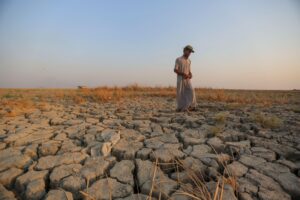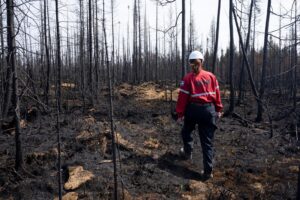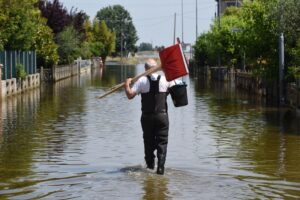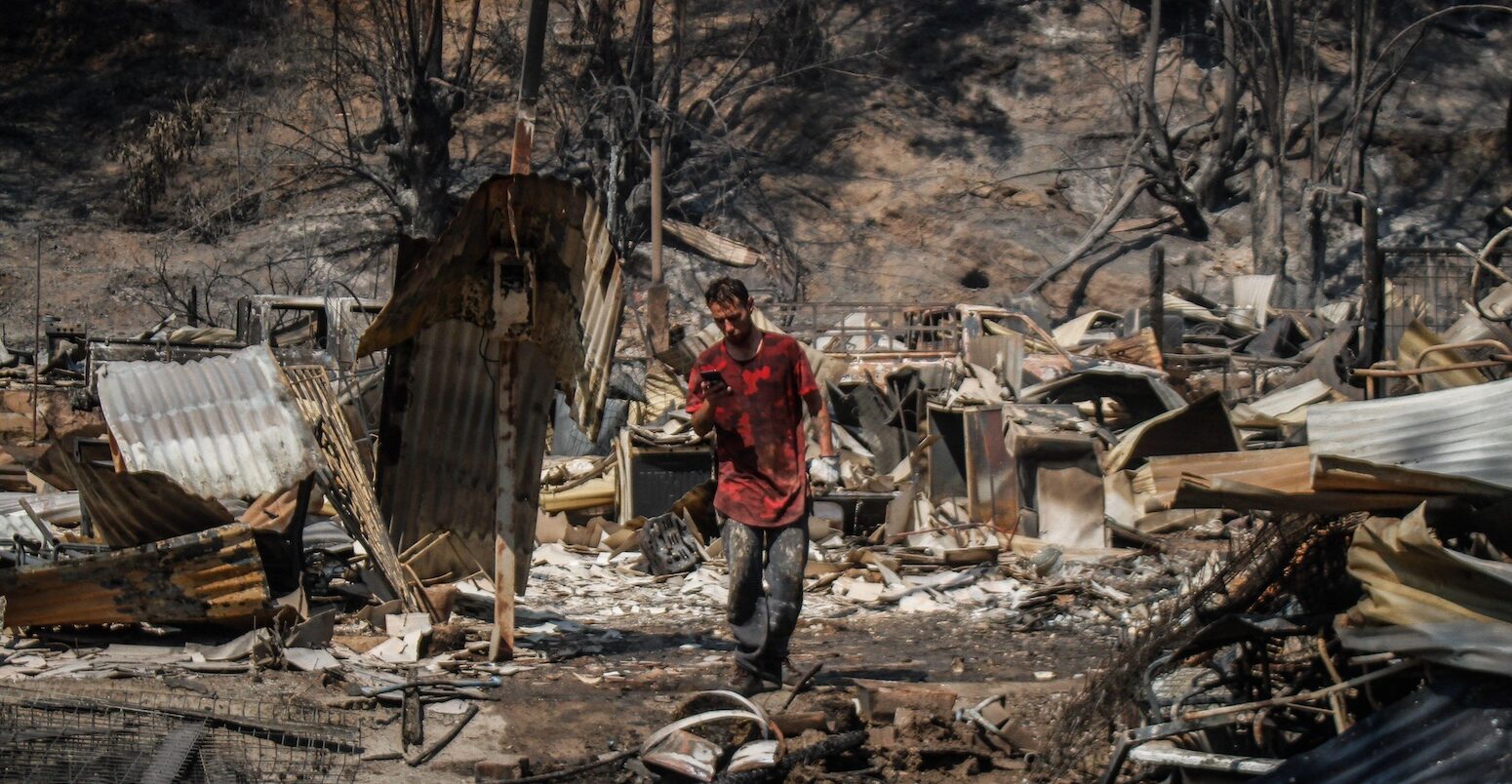
No ‘statistically significant’ link between climate change and Chile’s wildfires
Multiple Authors
02.22.24Multiple Authors
22.02.2024 | 5:01amClimate change did not have a statistically significant impact on the wildfires that hit Chile earlier this month, according to a new rapid attribution study by the World Weather Attribution service (WWA).
In early February, a series of wildfires broke out across the coast of Chile. Within just days, they burned more than 29,000 hectares of land, destroying more than 7,000 homes and killing more than 130 people.
“The wildfires were the world’s deadliest since the 2009 Australia bushfires,” according to the WWA.
The authors warn that “global warming will likely increase the risk of fire conditions in central Chile” if temperatures rise by 2C above pre-industrial temperatures. Moreover, it is already making the country hotter and drier – both risk factors for wildfires.
The study finds that climate change had made the observed fire conditions more likely, but this result was not statistically significant, meaning it could have occurred by chance.
The findings are also subject to fairly wide uncertainty. One reason is that coastal Chile is seeing a slight local cooling effect, the researchers say, due to shifting weather patterns.
In addition, the study notes that changes in land use – such as the growth of informal settlements in forest zones and widespread conversion towards non-native species and monoculture plantations – are making many regions of Chile “significantly more vulnerable” to wildfires.
’Perfect storm’
Forest fires in the Valparaíso region in central Chile started on 2 February. They then “spread rapidly through mountainous forests near Viña del Mar, Quilpué and Villa Alemana… [and] moved extremely quickly into the outskirts of cities”, WWA says in a press release, leaving more than 29,000 hectares burned since 4 February.
Chilean president Gabriel Boric described the fires as “the biggest tragedy we have experienced as a country since the earthquake of 27 February 2010”, according to La Tercera.
The most up-to-date death toll remains at 132, Chile’s La Tercera reported, while El Mercurio reported on the mental health impacts of the fires, with affected people suffering from anxiety and stress.
According to Diálogo Chino, Boric said that evacuating people had been made difficult by the speed at which the fires were spreading – in some areas at more than 10km per hour, faster than most people can walk.
The map below, taken from the attribution study, shows the burned area across the Viña del Mar-Valparaíso sector, highlighted in red. The yellow circles show active fires on 2 February.
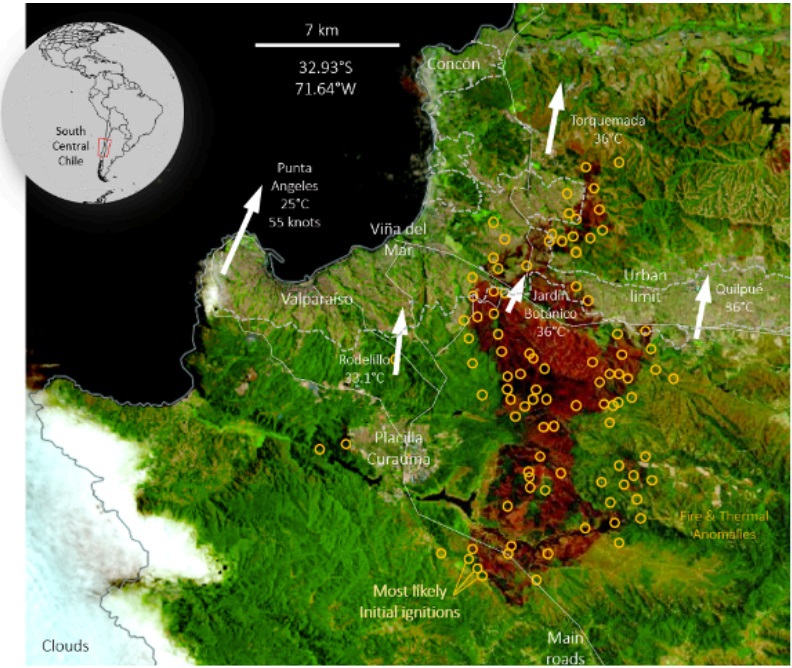
In an article by the NASA Earth Observatory, NASA research scientist Dr Elizabeth Wiggins suggested the wildfires “were the product of a perfect storm of conditions”, adding that “they occurred during a heatwave, drought and high-wind event borne from a combination of El Niño and climate change”.
Hot, dry and windy
The attribution study assesses the role of climate change on Chile’s fires between 31 January and 4 February, as these were the “highest fire intensity” days, when most of the impacts occurred, according to the study authors.
The intensity of a wildfire is influenced by a wide range of factors, such as atmospheric moisture, wind speed and fuel availability. The authors of this study focus on the “hot dry windy index” (HDWI) – a measure which combines maximum temperature, relative humidity and wind speed.
The study notes that this index does not take into account factors – such as the build-up of fuel – as other more “complex” indices do. However, the authors say the index is “an effective hazard metric for estimating threat to communities and difficulty of containment”.
The map below shows the maximum of average four-day HDWI between 31 January and 4 February 2024. Darker red indicates a higher HDWI, signifying hotter, windier and less humid conditions. The blue box indicates the study area.
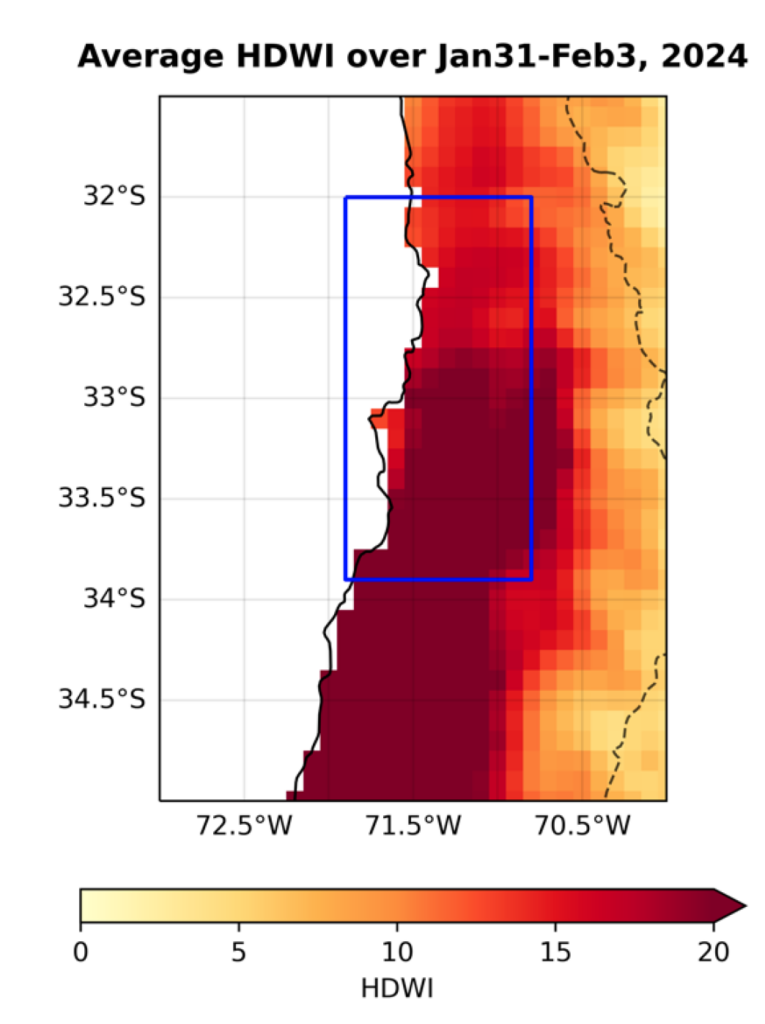
To put the wildfire into its historical context and determine how unlikely it was, the authors analyse a timeseries of HDWI. They find that the hot, dry and windy conditions that drove the wildfires of February 2024 are a one-in-30 year event in today’s climate.
To assess the role that climate change played in creating these weather conditions, the scientists use climate models to compare HDWI in this coastal region of Chile in the world as it is today, with a “counterfactual” world without human-caused climate change.
This is one approach to attribution, the fast-growing field of climate science that aims to identify the “fingerprint” of climate change on extreme-weather events.
The study finds a “small increase” in the HDWI due to climate change, but says that the trend is not “statistically significant”. (A statistically significant result would mean that an HWDI index as high as that seen during the wildfires in Chile is unlikely to be explained by chance.)
The authors also assess the individual components of the HDWI – maximum temperature, relative humidity and wind speed – but again find no “significant” trend due to climate change.
The study also uses two different indices to assess the extent whether the natural climate phenomenon El Niño had any impact on the dangerous fire weather conditions, but again finds “no significant influence”.
Finally, using the same models, the authors assess whether the fire would be more likely in a warmer world. Although the impact of climate change on fire weather in this year’s Chilean wildfires is “not yet significant”, they find that “global warming will likely increase the risk of fire conditions in central Chile if warming reaches 2C” above pre-industrial temperatures.
(These findings are yet to be published in a peer-reviewed journal. However, the methods used in the analysis have been published in previous attribution studies.)
Coastal cooling
It is “not surprising” that climate change did not have a statistically significant impact on Chile’s wildfires, the study says.
The authors explain that the coast of Chile is one of the few places in the world where climate change is causing a slight local cooling effect, due to a high-pressure year-round weather system in the south-east Pacific Ocean called the “South Pacific High”.
The study explains:
“Climate change is causing the South Pacific High to move southwards, leading to stronger southerly winds that are pushing deep, cold water to the coast of Chile. These cold waters replace warm, superficial water in a process called ‘upwelling’, which causes low temperatures along the coast, unlike inland Chile and the rest of South America.”
Tomás Carrasco Escaff, a researcher at the University of Chile’s Climate and Resilience Research Center (CR2) and author on the study, told a press briefing that this shift in the South Pacific High results in “coastal cooling”, which drives down HDWI. However, he adds that it also causes “competing” effects of “greater dryness” and “intensification of wind”, both of which act to increase HDWI.
Coastal cooling is also tricky for climate models to capture accurately – especially as the fires broke out on the “transition between the coast, which is cooling, and the inland part of the country which has a warming trend”, explained Dr Joyce Kimutai, a research associate at Imperial College London.
This, combined with the limited observational data available, means that there is a “relatively large degree of uncertainty” in the results of the study.
Contributing factors
Local media has also reported on the potential drivers of the fires. Citing a recent study, La Tercera said that climate change and El Niño have made the country more prone to “megafires” – those spanning more than 200 hectares.
The research noted that megafires – such as the ones registered in the summer of 2017 and 2023 – were influenced by both the high temperatures driven by El Niño and more frequent and intense heatwaves. It also showed that the central regions from El Maule to Araucanía – to the south of the Valparaíso region – have been the most affected by megafires between 2014 and 2023.
Diálogo Chino cited a 2020 study from CR2, which found that “since 2010, forest fires in south-central Chile have increased in terms of occurrences and area burned, compared to the previous three decades, while the average duration of the fire season has also become longer”.
The article noted that the “fire-affected south-central zone of Chile has been transformed by vast forest plantations of exotic species, especially pine and eucalyptus, introduced for timber and pulp production”. The CR2 study found that “exotic plants can modify the dynamics of forest fires, increasing the speed of spread, as well as their extent, frequency, intensity and seasonality”, the article said.
Diálogo Chino also said that infrastructure in Valparaíso “is another factor explaining the scale of the fires”. It added:
“Some of the burned areas are densely populated, with their expansion having often taken place without planning permission. Additionally, many houses there are informal dwellings that may have been constructed with flammable materials such as wood.”
This aligns with the findings of the attribution study, which notes:
“Fire risk is increasing notably due to current land management practices, such as the expansion of Wildland-Urban Interface areas (including the growth of informal settlements in forest zones) and widespread conversion from native to foreign and monoculture plantations.”
In addition, Diálogo Chino reported that Chile’s minister of the interior and public security Carolina Tohá claimed at least some of the recent fires may have been started intentionally.
Analysis Chile’s National Forest Corporation (CONAF) found that the main cause of 64% of fires in Chile from August 2023 to January 2024 is “negligence”, followed by intentional and accidental fires, and then 0.5% directly started by lightning. Negligence is driven by agricultural burning, which contributed the most to the fires, forestry work and the poor condition of power lines, the analysis found.
New draft law
The fires caused widespread destruction, with BioBioChile reporting that 7,000 houses had been damaged or destroyed. The government has estimated the reconstruction cost at up to $1bn, the outlet noted. Of those homes, 70% were in informal settlements, the attribution study notes.
BioBioChile also reported on the deaths of wildlife – including owls, thrushes, foxes, partridge and chinchilla mice – as a result of the fires.
Pedro Álvarez, forest engineer and forest chair at Reforestemos, a Chilean civil society organisation that implements forest restoration and fire prevention projects, travelled to the affected area. He tells Carbon Brief that some of the ecosystems harmed were native forests – home to native species such as the Chilean palm – and sclerophyllous forests, which are composed of shrubs and trees.
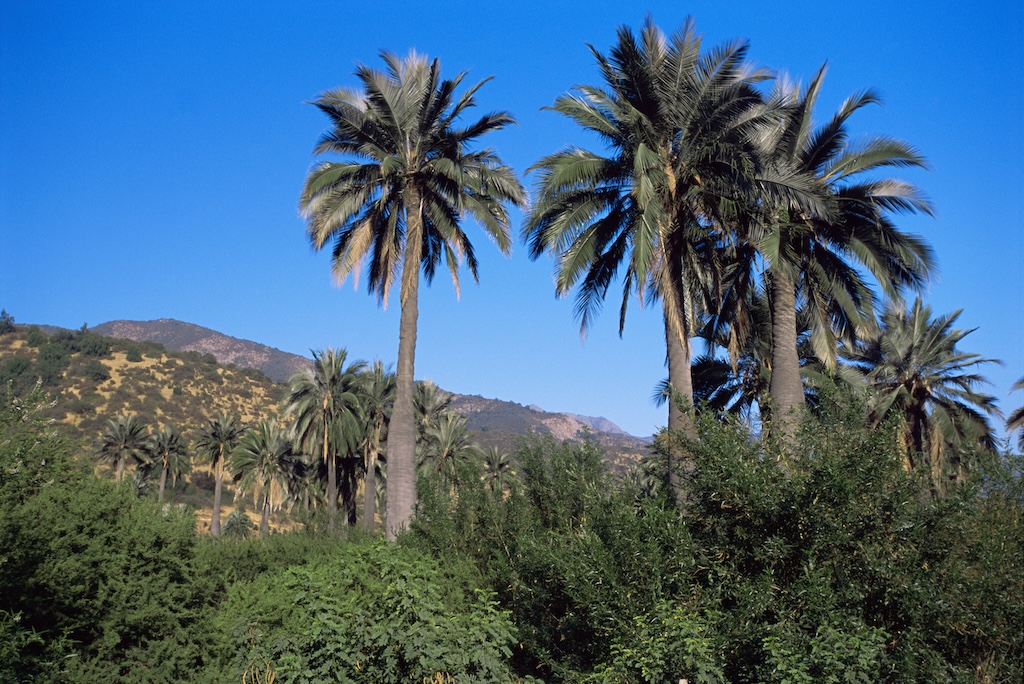
Due to the scale of the fires, a new bill is being discussed in Chile’s congress, and – according to a CONAF press release – the minister of agriculture, Esteban Valenzuela, has urged that this is finalised by April this year.
The draft law aims to prevent forest and rural fires – for example, by implementing spatial planning instruments to set up “measures to manage landscape” and creating preventative management plans on forest land, such as fuel-cutting belts and clearance of combustible material.
Álvarez tells Carbon Brief that the biggest challenge facing Chileans and the state right now is rebuilding the area. He suggests that public policies should focus on preventing fires, enhancing spatial planning and restoring key regions for ecosystem services and biodiversity.
-
No ‘statistically significant’ link between climate change and Chile’s wildfires

